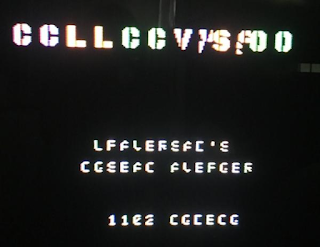I owned an Atari 5200 years before I had a ColecoVision, and the 5200 never gave me the kinds of problems the ColecoVision has. This machine may be the preferred console of the early 1980s for most gamers, but thanks to its substandard build quality, the ColecoVision is a system that quite literally hasn't aged well.
 |
| The stuff of nightmares. Yes, the 5200 controller is bad, but the ColecoVision controller isn't necessarily less bad. (image from Wikipedia) |
Next to meet the Grim Reaper is the power switch, which eventually fails due to wear and the industrial grease inside drying into clumps of oily goo. If your power switch no longer works, you're not playing ColecoVision games, necessitating a replacement. You used to be able to run down to the local Radio Shack and get an improved one (some even have lights inside, a welcome addition to a system with no LED indicators), but without a ready source for electronic components, your options are limited to Amazon and eBay. Have fun waiting for them to arrive.
 |
| Garbled graphics and faulty chips! That's how you know it's a Coleco! (image from AtariAge) |
Forty years after its release, the ColecoVision is an endless parade of hardware faults. I suspect we're going to see that happen to a LOT of game systems in the immediate future. Hell, the ColecoVision's second cousin, the Game Gear, is almost impossible to find in working condition thirty years later, thanks to leaking capacitors. Sega's not repairing that crap for you twenty years after it dropped out of the console race, so it's on you to fix the problems... if the capacitor acid hasn't already burned its way through vital circuits.
Then there are the game systems that came from the factory broken, like the early Xbox 360 with its red light of death, and the Playstation 2 with its disc read errors, forcing you to open the system and turn the potentiometer in just the right amount, so you can play Chulip instead of God of War. At least the ColecoVision had the courtesy to die long after it was discontinued by the manufacturer... Xbox 360 and Playstation 2 games were still on store shelves when my two systems took a dirt nap.Remember when you were younger, and you couldn't fathom these cutting edge systems breaking down from old age? Hell, I couldn't imagine playing The Legend of Zelda long enough to wear out the internal save battery, yet here we are, in an era of bit rot, dead batteries, leaking capacitors, and optical lenses that have developed cataracts. What was science-fiction in 1990s gaming fanzines has become a painful reality. That game system you cherished so as a child will probably die before you do.
Welcome to the future of gaming, ladies and gentlemen. It's been hell on the past.


No comments:
Post a Comment